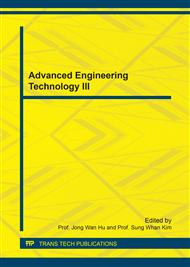p.518
p.525
p.532
p.539
p.547
p.554
p.561
p.565
p.573
Multiple Image Based Human Joint Angle Computation
Abstract:
This paper presents a new computation method for human joint angle. A human structure is modelled as an articulated rigid body kinematics in single video stream. Every input image consists of a rotating articulated segment with a different 3D angle. Angle computation for a human joint is achieved by several steps. First we compute internal as well as external parameters of a camera using feature points of fixed environment using nonlinear programming. We set an image as a reference image frame for 3D scene analysis for a rotating articulated segment. Then we compute angles of rotation and a center of rotation of the segment for each input frames using corresponding feature points as well as computed camera parameters using nonlinear programming. With computed angles of rotation and a center of rotation, we can perform volumetric reconstruction of an articulated human body in 3D. Basic idea for volumetric reconstruction is regarding separate 3D reconstruction for each articulated body segment. Volume reconstruction in 3D for a rotating segment is done by modifying transformation relation of world-to-camera to adjust an angle of rotation of a rotated segment as if there were no rotation for the segment. Our experimental results for a single rotating segment show our method works well.
Info:
Periodical:
Pages:
547-553
Citation:
Online since:
June 2017
Authors:
Price:
Сopyright:
© 2017 Trans Tech Publications Ltd. All Rights Reserved
Share:
Citation:


